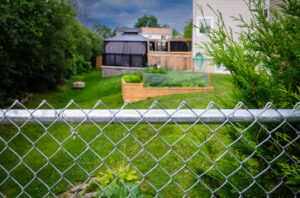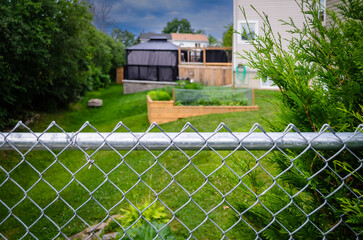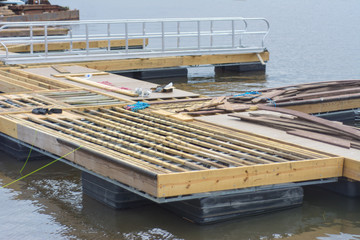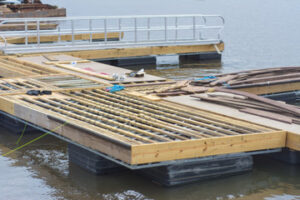Chain link fence is one of the most cost-effective fencing options. It can last decades and requires minimal maintenance.
The chain-link fence is made of a metal mesh fabric and galvanized framework. It can be coated in vinyl or powder coat to create a unique look.

Installation is relatively easy for a homeowner with basic tools unless the fence needs to be stretched and anchored, which can require a fence stretcher or come-along.
Chain link fences are a cost-effective way to secure your property. They also require little maintenance and are relatively easy to repair. For this reason, they are popular with homeowners who want to enclose their backyards and swimming pools. In addition, chain link fencing meets most building codes for pool enclosures. For commercial and industrial properties, they can offer a level of visibility that helps with supervision and monitoring activities.
Standard chain-link fences come in a variety of heights that range from three feet to 20 feet. They can be installed in a variety of configurations to meet your security needs, and most manufacturers offer custom sizes as well. The fence fabric, or mesh, can be made from a variety of materials, including aluminum, PVC, and stainless steel. The type of material used determines how durable the fence will be. For example, a galvanized fence is less likely to rust, but it may not hold up as well in harsh environments.
A popular feature of these fences is their ability to be customized with privacy slats. These slats are typically made from PVC or aluminum, and they can be installed vertically within the diamond-shaped gaps of traditional chain-link fences. This makes them more aesthetically pleasing while still allowing light and air to pass through the chain-link fence.
Another option is to use a vinyl or powder coating to cover the galvanized chain-link fence frame. This will give the fence a different look and help to protect the metal from corrosion. Some companies even offer aluminized coatings that are specifically designed to stand up better against road salt and other chemicals that can cause the galvanized finish to wear down more quickly.
If you’re concerned that someone might cut the top rail or drive a vehicle under the gate opening (which is usually 10-feet wide and can accommodate most cars), you can have your installer add closer line posts to the terminal posts. This will make it much more difficult to get under the fence and will prevent people from using vehicles to scale the structure.
Chain link fences have earned a reputation for their durability and security, but that doesn’t mean they can’t be beautiful. With innovative design options, like color-coated fencing, privacy slats, decorative inserts, customized gates, landscaping integration, and lighting effects, you can elevate your chain link fence to a stunning visual element that enhances the overall ambiance of your property.
While most chain-link fences are made from galvanized steel, they can be painted to match the aesthetic of your home or landscaping features. White or black paint offers a sleek, modern look that can complement any outdoor space. Earthy tones such as forest green or warm brown can blend in with natural themes, while vibrant colors like red can create a striking focal point.
Depending on your needs, you can also customize the size of the mesh in your fence. Larger meshes offer better visibility and greater strength, while smaller meshes provide increased privacy by limiting what can pass through the openings. For a more seamless look, you can even add reed screens or bamboo screens to your chain link fence for a more private feel.
One of the most simple ways to improve the appearance of your chain-link fence is by planting flowers or greenery along its sides. This will not only soften the harsh appearance of the fence, but it will also add color and fragrance to your garden. For a more dramatic effect, you can grow vines over your fence to create a wall of greenery. Some fast-growing vines, such as confederate jasmine, can quickly cover a chain-link fence.
Keep in mind, however, that it’s important to check with local authorities before making any modifications or additions to your fence. Many cities and municipalities have strict rules about fence height, material, and design, and failure to comply can result in fines. Keeping abreast of the latest innovations in chain-link fence designs allows contractors to better serve their customers and build trust. It also gives them new avenues to pitch creative solutions to their clients, and redefine what’s possible with this durable and reliable fencing material.
Chain link fences are sturdy and reliable barriers that provide an excellent level of security and privacy. They’re commonly used to create boundaries for playgrounds, pools, and recreational areas at parks and other public spaces. They help prevent unauthorized entry into protected spaces, while maintaining visibility and creating a welcoming ambiance for visitors. To maximize these benefits, you can select from a wide range of heights and mesh sizes. Choosing a smaller mesh size will minimize visibility, while a larger one can increase visibility and security.
A woven chain-link fence that features a high-density polyethylene screen is another option for privacy-minded customers. It is not only more affordable than a slatted fence, but it’s also durable and highly customizable. The screen can be painted to match your home’s aesthetic, and it’s available in multiple colors. It’s also water-, wind-, and UV-permeable. It’s a good choice for commercial or residential applications, and it comes with a 7-year manufacturer warranty.
The simplest way to add privacy to your chain-link fence is by covering it with a privacy screen. These can be purchased online and are designed to fit a standard chain-link fence. They are quick and easy to install, and they can achieve up to 70% visual coverage. However, they do require a bit of maintenance, as the screens are susceptible to wear and tear from the weather elements.
Another great option is to cover your fence with vines or hedges. They can add visual interest to your property and increase its value, but they may take a while to grow and fully cover the fence. If you’re not comfortable taking on the responsibility of caring for the plants, you can hire a landscaping company to do it for you.
You can also add reed or bamboo screens to your chain-link fence. These will require a bit more maintenance than a vine or hedge, but they offer an excellent amount of privacy and visual coverage. You can even use them to create a unique design or pattern for your fence, making it an interesting focal point in your backyard.
Whether you are looking to protect your business or your home, a fence is an important investment. A chain link fence offers a level of security that is cost-effective and durable. It is also resistant to rust, making it an ideal fencing option for both commercial and residential properties.
A chain link fence is composed of a steel mesh fabric that is bent and interlocked to create a sturdy barrier. Different gauges of wire are used to create varying degrees of strength. These materials are then galvanized to ensure durability. This type of fence is also known as a cyclone or hurricane fence due to its ability to protect property in a strong storm.
The framework of a chain link fence is made up of steel tubing that functions as posts. This frame is then filled with concrete to provide support. The tension rods that are used to hold the chain link fabric in place are then attached to the posts. Some chain link fences require brace bands to help keep the tension bars in place. These can be placed at the end or corner posts.
When the metal of a chain link fence is exposed to direct sunlight or harsh weather conditions, it can rust over time. To prevent this, it is essential to paint the fence with a protective coating. Polymer and PVC coatings are becoming increasingly popular because of their ability to protect the fence against rust and other elements.
Maintenance of a chain link fence can be relatively easy. A hose down every now and then can often do the trick. This helps to keep the fence clean and free of debris like bird poop and caked-on mud.
In addition to removing any growth of plants or trees, it is important to make repairs as needed. Vines and other plant growth can cause the connections of a chain link fence to wear out. These connections can also loosen and pull away from the posts. If this happens, it is best to call a professional for repairs as soon as possible.


